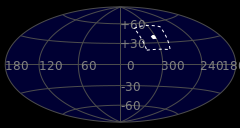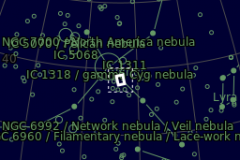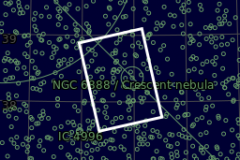
The Crescent Nebula (also known as NGC 6888, Caldwell 27, Sharpless 105) is an emission nebula in the constellation Cygnus, about 5000 light-years away from Earth. It was discovered by Friedrich Wilhelm Herschel in 1792. It is formed by the fast stellar wind from the Wolf-Rayet star WR 136 (HD 192163) colliding with and energizing the slower moving wind ejected by the star when it became a red giant around 250,000 to 400,000 years ago. The result of the collision is a shell and two shock waves, one moving outward and one moving inward. The inward moving shock wave heats the stellar wind to X-ray-emitting temperatures.
It is a rather faint object located about 2 degrees SW of Sadr. For most telescopes it requires a UHC or OIII filter to see. Under favorable circumstances a telescope as small as 8 cm (with filter) can see its nebulosity. Larger telescopes (20 cm or more) reveal the crescent or a Euro sign shape which makes some to call it the “Euro sign nebula”. (Source: Wikipedia)
Technical Details
Dates: 5/5/2018 – 7/5/2018
Location: Cologne, Germany
Imaging Telescope: 8″ GSO f/4 (Carbon Tube)
Imaging Camera: Nikon D7000
Filter: Baader Planetarium UHC-S
Mount: Skywatcher EQ-6
Guiding Telescope: TSO 80mm
Guiding Camera: QHY 5L-II
Integration: 80 x 5 min. (ISO 1000)
Software: PixInsight, SofortBild, OpenPhDGuiding, INDI
Plate Solution

(Source: astrometry.net)


